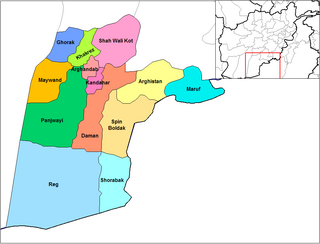
Nimruz or Nimroz is one of the 34 provinces of Afghanistan, located in the southwestern part of the country. It lies to the east of the Sistan and Baluchestan province of Iran and north of Balochistan, Pakistan, also bordering the Afghan provinces of Farah and Helmand. It has a population of about 186,963 people. The province is divided into five districts, encompassing about 649 villages.
Farah is the capital and largest city of Farah Province in western Afghanistan. It is located on the Farah River, close to the border with Iran. It is one of the largest cities of western Afghanistan in terms of population, with about 1.5 million people living in its urban area.
Deh Rawood is a district in Uruzgan Province, southern Afghanistan, and the name of the town that serves as district seat. Deh Rawood lies along the Helmand River. The tribes in the district are Pashtun, dominated by the Noorzai and Populzai sub-tribes.

Shortly after the September 11 attacks, the United States declared the war on terror and subsequently led a multinational military operation against Taliban-ruled Afghanistan. The stated goal was to dismantle al-Qaeda, which had executed the attacks under the leadership of Osama bin Laden, and to deny Islamist militants a safe base of operations in Afghanistan by toppling the Taliban government. The United Kingdom was a key ally of the United States, offering support for military action from the start of the invasion preparations. The American military presence in Afghanistan greatly bolstered the Northern Alliance, which had been locked in a losing fight with the Taliban during the Afghan Civil War. Prior to the beginning of the United States' war effort, the Taliban had seized around 85% of Afghanistan's territory as well as the capital city of Kabul, effectively confining the Northern Alliance to Badakhshan Province and smaller surrounding areas. The American-led invasion on 7 October 2001, marked the first phase of what would become the 20-year-long War in Afghanistan.

The following items form a partial timeline of the War in Afghanistan. For events prior to October 7, 2001, see 2001 in Afghanistan.

Arghandab District is a District of Zabul Province, Afghanistan. The population in 2019 was estimated at 36,298.

The Battle of Arghandab, codenamed Operation IBRAT by the insurgents, began on June 18, 2008, when NATO-led forces attacked Taliban militants in response to Taliban attacks in Arghandab District and Kandahar in Afghanistan. The battle in Arghandab marked the second time in less than a year that the Taliban tried to take control of the area.

The Battle of Kunduz took place from April to October 2015 for control of the city of Kunduz, located in northern Afghanistan, with Taliban fighters attempting to seize the city and displace Afghan security forces. On 28 September 2015, the Taliban forces suddenly overran the city, with government forces retreating outside the city. The capture marked the first time since 2001 that the Taliban had taken control of a major city in Afghanistan. The Afghan government claimed to have largely recaptured Kunduz by 1 October 2015 in a counterattack, although local sources in the city disputed the claim made by government officials.
The following lists events that happened during 2016 in Afghanistan.

Operation Omari, also called the Spring Offensive, was an offensive launched by the Taliban against the Afghan government in Afghanistan. Its start was announced on 12 April 2016. The Taliban made their yearly spring offensive announcement on April 12, 2016. They named the offensive in honor of the movement's late leader. The announcement of Operation Omari includes details on how the members of the group should present themselves in public. The aim of the Operation is considered ambitious and its focus is on clearing the remaining areas from enemy control and presence. Unlike offensive announcements from previous years this announcement contained details about specific targets that would be attacked during the operation. The targets were stated in general terms with reference only to "large scale attacks on enemy positions across the country, martyrdom-seeking and tactical attacks against enemy strongholds, and assassination of enemy commanders in urban centers."
The Battle of Kunduz occurred on 3 October 2016 in the Afghan city of Kunduz between Afghan National Security Forces and Taliban insurgents. It occurred exactly a year after the 2015 battle when the Taliban briefly controlled the city.
Events in the year 2018 in Afghanistan.

The Ghazni offensive began on 10 August 2018, when Taliban fighters launched an assault on the city of Ghazni, Afghanistan's sixth largest city and one which has been culturally and strategically important for much of the country's history. The attack resulted in the deaths of hundreds of insurgents, soldiers, police, and civilians. The city also sustained large-scale property damage. The battle, occurring only weeks before Afghanistan's 2018 parliamentary election, was the largest since a three-day truce in June had raised hopes of peace talks.

The Battle of Darzab was a major conflict between the Taliban and the Islamic State's Khorasan Province (ISIS–K) who fought each other over control of Jowzjan Province's Darzab District in Afghanistan. Following heavy clashes, ISIS–K was defeated, with most of the group's forces in Jowzjan Province killed or captured.
This article summarizes the history of the War in Afghanistan (2001–2021).

The Islamic State–Taliban conflict is an ongoing insurgency waged by the Islamic State – Khorasan Province (IS-KP) against the Taliban regime in Afghanistan. The conflict initially began when both operated as rival insurgent groups in Nangarhar; since the formation of the Taliban's state in 2021, IS-KP members have enacted a campaign of terrorism targeting both civilians and assassinating Taliban members using hit-and-run tactics. The group have also caused incidents and attacks across the border in Pakistan.

The 2021 Taliban offensive was a military offensive by the Taliban insurgent group and allied militants that led to the fall of the Islamic Republic of Afghanistan and the end of the nearly 20-year War in Afghanistan that had begun following the United States invasion of the country. The Taliban victory had widespread domestic and international ramifications regarding human rights and proliferation of terrorism. The offensive included a continuation of the bottom-up succession of negotiated or paid surrenders to the Taliban from the village level upwards that started following the February 2020 US–Taliban deal.
The Battle of Lashkargah was fought between the Afghan National Security Forces (ANSF) and the Taliban for control of the city of Lashkargah. The United States supported Afghan forces with airstrikes. The fighting started in late July 2021, and clashes occurred around the governor's residence, NDS headquarters, police headquarters, and prison. The police headquarters was captured by the Taliban on 12 August 2021, and the last government forces evacuated or surrendered in the night from 12 to 13 August 2021. More than 40 civilians were also killed in the fortnight-long fighting.

The Battle of Kandahar began on 9 July 2021, as Taliban insurgents assaulted the city to capture it from the Afghan National Security Forces (ANSF). After heavy fighting for weeks the city's defenses had started to dissolve in August. This allowed the Taliban to enter and overrun most of the city on 12 August 2021, including the Sarposa prison, which included the release of over 1,000 prisoners, and ultimately the capture of the city. However, the siege for the nearby airport continued, where government loyalists held out until being evacuated on 16 August.
The Battle of Kunduz took place between the Afghan National Security Forces (ANSF) and the Taliban for control of the city of Kunduz. The fighting started in late June and lasted until the city was overrun by the Taliban on 8 August. The Afghan government forces, defending the city, withdrew to 217th Pamir Corps headquarters and airport within the city. After resisting for three days, an entire 217th Pamir Corps had surrendered, allowing Taliban to take control of the airport and a number of military vehicles and tanks stationed inside the headquarters.












